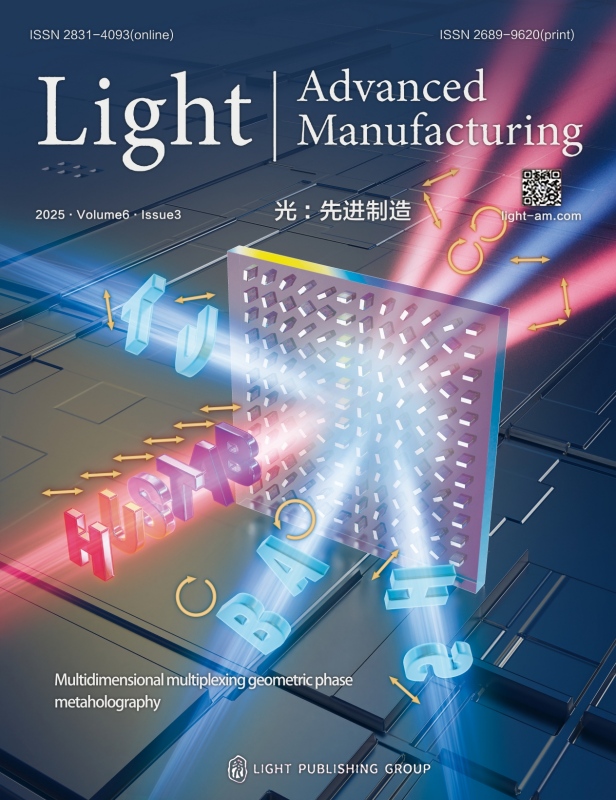Guest Editors:

Dr. Dai Zhang
Institute of Physical and Theoretical Chemistry,
Eberhard Karls University of Tübingen, Germany
Dr. Dai Zhang is a research group leader at the Eberhard Karl’s University of Tübingen, Germany. Her research interests lie in the field of high-resolution optical microscopy and spectroscopy and their applications in semiconductor materials. She has authored or co-authored more than 100 refereed journal papers with over 3000 citations, and has delivered over 50 invited talks at international and national conferences. She was awarded Annual Prize for exceptional young scientists from the Work Association of German University Professors for Chemistry; and the Helene-Lange-Prize for outstanding young female scientists for their exceptional work in research and teaching, Germany.

Dr. Hai Bi
Jihua Laboratory, P. R. China
Dr. Hai Bi is the principle investigator and the founder of the Germany-China Joint Innovation Laboratory at Ji Hua Laboratory. He completed his B.S. and M.S. degree in Chemistry at Jilin University in 2007 and 2010, respectively, and received his doctoral degree in Physics from Technique University of Munich in 2014. Afterwards, he worked as a research associate at Harvard University (2015-2019). In 2020, he started his work at Ji Hua Laboratory. His research focuses on super-resolution microscopy with near-field enhanced mechanism, organic semiconductors and optoelectronic devices. He is devoted to developing methods and technologies for practical industrial fields, especially for OLED technique.
Call for Papers:
Join a special edition of the journal Light – Advanced Manufacturing. This is a new, highly selective, open-access, and free of charge international sister journal of the Nature Journal Light: Science & Applications. The journal is aimed to publish innovative research in all modern areas of preferred light-based technologies, including fundamental and applied research as well as industrial innovations.
Please see: http://www.light-am.com/index.htm
Submission to the Special Issue:
The submission deadline to ensure inclusion in the special topic is August 31, 2022.
All papers, including invited papers, will be subject to the same rigorous review process as is usual for publication in Light: Advanced Manufacturing. After peer review, papers accepted to the special topic will be published as ready without delay in a regular issue of the journal, and will also populate a virtual collection. As such, inclusion in the special topic will not delay publication in any way. For examples of other special topics in Light: Advanced Manufacturing, please visit the journal website.
Submissions are open now. Please submit your article through our online submission system.
When submitting your manuscript please follow instructions below:
1. Please contribute your manuscript via https://mc03.manuscriptcentral.com/lam and indicate that it is for the Special Issue on ‘Nanospectroscopy, nanooptics, and nanofabrication’ in the cover letter.
2. Please refer to http://www.light-am.com/news/guidance.htm for author guidance.
3. If further assistance is needed, please contact the Editorial Office via light_am@jihualab.ac.cn.
The Reason:
With this special issue ‘Nanospectroscopy, nanooptics and nanofabrication’, we wish to highlight the rapid experimental and theoretical advances of this burgeoning interdisciplinary field, as well as to provide an account of its peculiar challenges and future prospects. Advances in understanding the fundamental mechanisms of optical resolution at the nanometer and Angstrom regime, novel simulation methods, and applications of these fundamental mechanisms are the main components. Furthermore, this special issue aims at promoting novel fabrication techniques which allow to reproduce the nano- or pico-scale environment for the near-field confinement, which deem to improve or open up enormous new horizontal of the research topics in the field of nanooptics, nanospectrosopy and picospectroscopy.
Topics of interest include but are not limited to
· New techniques and theories related to the tip-enhanced optical spectroscopy
· New techniques and theories related to the near-field confinement and excitation dynamics
· Novel technologies for ultrahigh-precision nano-fabrication
· Light-matter interactions in the nanometer, and quantum regimes
Historically, the intramolecular motions are pictorially illustrated using wiggling balls and connecting springs to represent atoms and bonds. Until recently these motions were optically revealed by their Raman scattered light, allowing us to literally ‘see’ how individual atoms vibrate within a chemical bound. Arriving at this point took us a journey of nearly 90 years, and what is presented in front of us is a wonderful intramolecular universe full of fascinations and surprises.
As early as 1928, Irish scientist E. Synge proposed a method to overcome the classical optical resolution limit. He exchanged several letters with A. Einstein in which he described two ideas. The first was to put a tiny metal particle in the focus of a lens and collect the particle's scattered light. The second suggestion involved a very fine hole in an otherwise opaque device. This aperture should be smaller than the light wavelength and it should be raster-scanned over the sample surface [1]. Synge even foresaw the use of piezo-electric devices for fast scanning with high lateral precision [2]. Yet in terms of a technical realization, Synge was ahead of his time. Only in the mid-1980s, his second idea began to be fulfilled in the form of aperture scanning near-field optical microscopy. With the combination of scanning probe microscope and optical microscopy, scanning near-field optical microscopy continuously pushed the optical resolution to new records, far beyond the diffraction limitation for the conventional optical microscopy [3-6].
Being able to provide molecular fingerprints, Raman spectroscopy were combined with scanning near-field optical microscopy in the early 2000, which further opened up the opportunity of identifying chemical information with nanometer spatial resolution [7]. Incessant outcomes from this combination appeared in the following years, whose technical and scientific progresses continuously stimulated and motivated us to further explore the ultimate spatial resolution of optical microscopy [8-24]. In 2013, a research group led by Zhenchao Dong and Jianguo Hou at University of Science and Technology of China (USTC) demonstrated sub-nanometer resolved single-molecule Raman mapping for the first time [25], pushing the spatial resolution with chemical identification capability down to ~5 Å. Since then, international researchers have been pursuing single-molecule Raman imaging technique to explore what is the ultimate limit of the spatial resolution and how this technique can be best utilized.
In 2019, two further milestone achievements were independently published by the CaSTL scientists entitled ‘Visualizing vibrational normal modes of a single molecule with atomically confined light’ [26], and by the USTC group entitled "Visually constructing the chemical structure of a single molecule by scanning Raman picoscopy" [27]. Both groups demonstrated the unprecedent spatial resolution down to the Angstrom regime at the single-chemical-bond level. The full spatial mapping of various intrinsic vibrational modes in the intramolecular universe were successfully revealed. The ability of such Angstrom-resolved spatial resolution to determine the chemical structure of unknown molecules arouse extensive interests of researchers in the fields of chemistry, physics, materials, biology, and stimulated active research to explore the underlying super-resolution mechanisms, to interpret the experimental data, and to mature the technique for wider applications. The combination of these factors raises questions for new theory and calls for further experimental investigations, which are the main motivation for the initiation of this special issue.
[1] E. H. Synge (1928). A suggested method for extending microscopic resolution into the ultra-microscopic region. The London, Edinburgh, and Dublin Philosophical Magazine and Journal of Science, 6(35), 356–362.
[2] E. H. Synge (1932). An application of piezo-electricity to microscopy. The London, Edinburgh, and Dublin Philosophical Magazine and Journal of Science, 13(83), 297–300.
[3] E. Betzig & J. K. Trautman (1992). Near-field optics: Microscopy, spectroscopy, and surface modification beyond the diffraction limit. Science, 257(5067), 189–195.
[4] B. Hecht, B. Sick, U. P. Wild, V. Deckert, R. Zenobi, O. J. F. Martin, & D. W. Pohl (2000). Scanning near-field optical microscopy with aperture probes: Fundamentals and applications. The Journal of Chemical Physics, 112(18), 7761–7774.
[5] L. Novotny & B. Hecht (2006). Principles of nano-optics. Cambridge University Press.
[6] A. J. Meixner (1995). Super-resolution imaging and detection of fluorescence from single molecules by scanning near-field optical microscopy. Optical Engineering, 34(8), 2324–2332.
[7] R. M. Stöckle, Y. D. Suh, V. Deckert, & R. Zenobi (2000). Nanoscale chemical analysis by tip-enhanced Raman spectroscopy. Chemical Physics Letters, 318(1-3), 131–136.
[8] E. Bailo & V. Deckert (2008). Tip-enhanced Raman spectroscopy of single RNA strands: towards a novel direct-sequencing method. Angewandte Chemie International Edition, 47(9), 1658–1661.
[9] K. F. Domke, D. Zhang, & B. Pettinger (2007). Tip-enhanced Raman spectra of picomole quantities of DNA nucleobases at Au (111). Journal of the American Chemical Society, 129(21), 6708–6709.
[10] A. Hartschuh, E. J. Sánchez, X. S. Xie, & L. Novotny (2003). High-resolution near-field Raman microscopy of single-walled carbon nanotubes. Physical Review Letters, 90(9), 095503.
[11] M. Sackrow, C. Stanciu, M. A. Lieb, & A. J. Meixner (2008). Imaging nanometre-sized hot spots on smooth Au films with high-resolution tip-enhanced luminescence and Raman near-field optical microscopy. Chemphyschem, 9(2), 316–320.
[12] N. Jiang, E. T. Foley, J. M. Klingsporn, M. D. Sonntag, N. A. Valley, J. A. Dieringer, & R. P. Van Duyne (2012). Observation of multiple vibrational modes in ultrahigh vacuum tip-enhanced Raman spectroscopy combined with molecular-resolution scanning tunneling microscopy. Nano Letters, 12(10), 5061–5067.
[13] B. Pettinger, B. Ren, G. Picardi, R. Schuster, & G. Ertl (2004). Nanoscale probing of adsorbed species by tip-enhanced Raman spectroscopy. Physical Review Letters, 92(9), 096101.
[14] J. H. Zhong, X. Jin, L. Meng, X. Wang, H. S. Su, Z. L. Yang, & B. Ren (2016). Probing the electronic and catalytic properties of a bimetallic surface with 3 nm resolution. Nature Nanotechnology, 12(2), 132–136.
[15] S. C. Huang, X. Wang, Q.-Q. Zhao, J.-F. Zhu, C.-W. Li, Y.-H. He, S. Hu, M. M. Sartin, S. Yan, B. Ren (2020), Probing nanoscale spatial distribution of plasmonically excited hot carriers. Nature Communication, 11, 4211.
[16] J. Steidtner & B. Pettinger (2008). Tip-enhanced Raman spectroscopy and microscopy on single dye molecules with 15 nm resolution. Physical Review Letters, 100(23), 236101.
[17] M. S. Anderson (2000). Locally enhanced Raman spectroscopy with an atomic force microscope. Applied Physics Letters, 76(21), 3130–3132.
[18] N. Hayazawa, Y. Inouye, Z. Sekkat, & S. Kawata (2000). Metallized tip amplification of near-field Raman scattering. Optics Communications, 183(1-4), 333–336.
[19] T. Yano, P. Verma, Y. Saito, T. Ichimura, & S. Kawata (2009). Pressure-assisted tip-enhanced Raman imaging at a resolution of a few nanometres. Nature Photonics, 3(8), 473–477.
[20] D. Zhang, U. Heinemeyer, C. Stanciu, M. et al. (2010). Nanoscale spectroscopic imaging of organic semiconductor films by plasmon-polariton coupling, Physical Review Letters, 104 (5) 056601.
[21] X. Wang, D. Zhang, K. Braun, et al. (2010) High-resolution spectroscopic mapping of the chemical contrast from nanometer domains in P3HT:PCBM organic blend films for solar cell applications, Advanced Functional Materials, 20 (3) 492-499.
[22] K. D. Park, T. Jiang, G. Clark, et al. (2018) Radiative control of dark excitons at room temperature by nano-optical antenna-tip Purcell effect. Nature Nanotechnology, 13, 59–64.
[23] R. S. Alencar, C. Rabelo, H. L. S. Miranda, et al. (2019) Probing Spatial Phonon Correlation Length in Post-Transition Metal Monochalcogenide GaS Using Tip-Enhanced Raman Spectroscopy, Nano Letters, 19, 7357−7364.
[24] T. P. Darlington, C. Carmesin, M. Florian, M. et al. (2020) Imaging strain-localized excitons in nanoscale bubbles of monolayer WSe2 at room temperature. Nature Nanotechnology, 15, 854–860.
[25] R. Zhang, Y. Zhang, Z. C. Dong, S. Jiang, C. Zhang, L. G. Chen, J. G. Hou (2013). Chemical mapping of a single molecule by plasmon-enhanced Raman scattering. Nature, 498(7452), 82–86.
[26] J. Lee, K. T. Crampton, N. Tallarida, & V. Ara Apkarian (2019). Visualizing vibrational normal modes of a single molecule with atomically confined light. Nature, 568, 78–82.
[27] Y. Zhang, B. Yang, A. Ghafoor, Y. Zhang, Y. F. Zhang, R. P. Wang, & J. G. Hou (2019). Visually constructing the chemical structure of a single molecule by scanning Raman microscopy. National Science Review, 6, 1169.









 Email
Email RSS
RSS